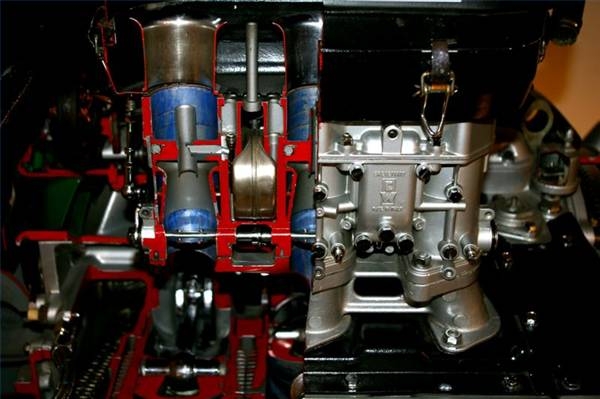
The purpose of a carburetor is to blend fuel and air for ignition in an internal combustion engine. Since they were invented in the late-nineteenth century, carburetors have evolved along with other parts of automotive technology toward more powerful, efficient engines. Today carburetors are largely absent from mainstream cars, having been replaced by fuel injection systems over the past several decades.
All carburetors blend fuel and air evenly, preparing it for entry to an engine's combustion chamber. Different types of carburetors accomplish this differently, though all rely on the Bernoulli principle, which involves the dynamic pressure of an air flow. Carburetors meter the pressure of air being drawn in to the engine and adjust the amount of fuel accordingly.
The main difference between most carburetors is the placement of their air intakes. When air is drawn from the side of a carburetor, it is known as a sidedraft carburetor. When the air is drawn from above, it is known as a downdraft carburetor. Placement of air intakes allows carburetors to be mounted at different points in a vehicle's engine compartment, or stacked among a series of carburetors without blocking their intakes.
The simplest carburetors contain a single intake, or barrel, through which air flows. More complex carburetors, known as multibarrel carburetors, may feature several barrels that allow more air to enter the engine. This is especially useful for engines with large volumes and greater air requirements.
On a multibarrel carburetor, one barrel may be designated as the primary barrel, and it will function at all times. Secondary barrels will be activated when more air is needed than the primary barrel can provide when fully open. But not all muitlbarrel carburetors open in stages as described here. Some, like those on racing engines, may open all barrels at once. Other multibarrel carburetors may serve the purpose of two separate carburetors, feeding air in two different directions toward two banks of cylinders (as in a V engine configuration).
Any given carburetor can be identified as being either fixed choke or variable choke. Fixed choke carburetors are more common for basic automotive applications. They are usually designed with downdraft air intake. In a fixed choke carburetor, the air flowing into the barrel creates pressure which allows only a certain amount of fuel to flow into the carburetor. As pressure increases, less fuel flows in. When pressure decreases, more fuel may enter.
Variable flow carburetors, sometimes called constant depression carburetors, are usually sidedraft carburetors which use air pressure to operate a connecting pin which engages with the jet through which fuel enters. This system indirectly varies the opening of the fuel jet, thus controlling the amount of fuel allowed to enter the carburetor.
Although not common in cars, some carburetors can be manually controlled by the driver. These include motorcycle and aircraft carburetors. In the case of an aircraft engine, the amount of air entering the engine is only one factor to consider. The density of that air is also important, since at higher altitudes the air quality is very different and less oxygen is present for combustion. The pilot may be able to control the choke, thus allowing more air in to maintain engine power at higher altitudes.
Motorcycles may employ a sidedraft carburetor with a manual control that allows the driver to flood the carburetor with fuel, making it easier to start a cold engine. The disadvantage of this feature is the possibility that fuel will overflow the carburetor and end up on the engine itself, where it would burn once the engine heats up.
One of the important functions of a carburetor is not only to blend fuel and air in the proper ratio, but to do so evenly for the best possible (smoothest and most powerful) combustion. Catalytic carburetors include a catalytic metal (usually platinum or nickel) which chemically reacts with the fuel to help sort out impurities and ensure a uniform solution enters the combustion chamber. The catalytic material essentially breaks the fuel down into its elemental components, allowing it to mix more evenly.
The catalytic carburetor is a forerunner to the modern catalytic converter, which is part of an engine's exhaust system where it helps break down harmful exhaust fumes.